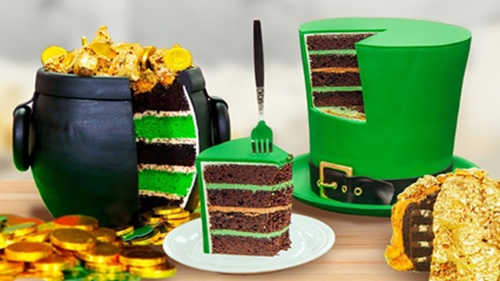
Happy St. Patrick’s Day
St. Patrick’s Day is a delightful celebration filled with vibrant green hues, festive parades, and a whole array of delicious treats. While traditional Irish dishes often take center stage, desserts can steal the spotlight with their creativity and festive flair.
The classic shamrock-shaped sugar cookie is one of the most popular St. Patrick’s Day desserts. These buttery cookies are rolled out and cut into whimsical shamrock shapes, then decorated with a luscious green icing and sprinkles. They’re perfect for sharing at gatherings or enjoying with a warm cup of tea.
Another favorite is the rich and creamy Irish cream cheesecake. Combining the smooth texture of cream cheese with the delightful flavor of Irish cream liqueur, this dessert can be served on a graham cracker crust and garnished with chocolate shavings or a drizzle of caramel sauce. Each slice is a decadent celebration of flavor, making it a hit at any St. Patrick’s Day party.
For a bit of fun, consider rainbow cupcakes topped with green-tinted frosting. These vibrant confections start with layers of colorful cake batter that, when baked, create a beautiful rainbow effect. Crowned with fluffy green buttercream and perhaps a sprinkle of edible gold glitter, these whimsical cupcakes will brighten the festivities.
Lastly, no St. Patrick’s Day dessert roundup would be complete without the classic Irish soda bread pudding. Cubes of dense, sweet soda bread are soaked in a rich custard and baked until golden, resulting in a warm, comforting dish. Topped with a drizzle of whiskey sauce, it offers a unique twist that perfectly complements the holiday’s spirit.
Whether it’s cookies, cupcakes, or custard, St. Patrick’s Day desserts add a touch of sweetness and joy to the celebration, making this day a memorable treat for all.
St. Patrick’s Day, celebrated on March 17th, is a cultural and religious holiday commemorating Saint Patrick, the patron saint of Ireland. Originally a feast day, it has evolved into a worldwide celebration of Irish culture, marked by vibrant festivities, parades, and green attire.
Saint Patrick was a 5th-century missionary credited with bringing Christianity to Ireland. He is famously associated with the shamrock, which he used to explain the Holy Trinity to the Irish people. According to legend, he also banished snakes from Ireland, symbolizing the eradication of paganism. As a result, March 17th, the date of his death, became a day of observance for the Irish Catholic community.
Over time, St. Patrick’s Day transcended its religious origins, celebrating Irish heritage globally. Irish immigrants, particularly in the United States, played a significant role in shaping the holiday into what it is today. The first recorded St. Patrick’s Day parade occurred in New York City in 1762, organized by Irish soldiers serving in the British Army. Today, these parades feature lively music, traditional Irish dancing, and elaborate floats, attracting millions of participants and spectators.
Today, people often wear green, a color associated with Ireland’s lush landscapes and the shamrock. This practice is frequently accompanied by festivities, including feasting on traditional Irish foods, like corned beef and cabbage, and enjoying beverages, especially green beer or Irish whiskey.
St. Patrick’s Day has become a unifying celebration beyond national boundaries, inviting people of all backgrounds to partake in the joyous festivities, embrace Irish traditions, and celebrate cultural diversity. Whether through parades, music, or communal gatherings, it is a day of revelry and goodwill, fostering a spirit of friendship and community across the globe.